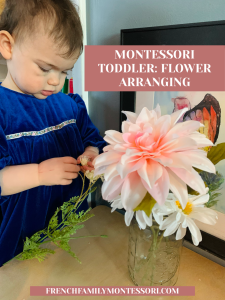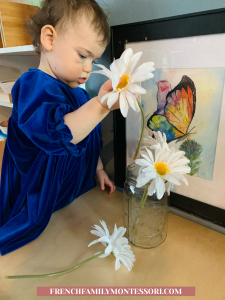
Have you noticed that you don’t see cut flowers around our house? I read the following quote from Osho many years ago and it resonated in such a way that we only have potted plants: “If you love a flower, don’t pick it up. Because if you pick it up it dies and it ceases to be what you love. So if you love a flower, let it be. Love is not about possession. Love is about appreciation.”
Yes, it speaks to more than flower, but it still hit home. This is also why I love propagating plants with E and V so much, teaching growth.
There’s a traditional activity that you see many Montessori children doing: flower arranging. There are so many different skills and learning opportunities that embody flower arranging: water pouring, cutting of the stem, potential removal of leaves, and learning the names of the flowers and it parts (botany). It also brings beauty into the environment. “The child should live in an environment of beauty.”–Maria Montessori
The child must practice care not only in their water pouring but also in the way they delicately handle the flowers, so they won’t be damaged. If too rough, there’s risk of petal loss and bent stems.
I wanted to provide something similar to E and V, the ability to make beautiful bouquets and centerpieces, while still being true to the how I felt about cut flowers (which may very well change in time). So I searched for artificial flowers that were realistic looking and would require gentle handling.

When I came across these particular artificial flowers at Target I knew they would work wonderfully! You’ll notice a small variety of flowers I explicitly chose. Some of the flowers have no leaves, making them easy to place in the vase; while other have a few or many. I picked these out specifically to increase the level of difficulty over time.
This particular activity may not allow us to practice water pouring or cutting of stems, but they have been required to handle them carefully as a few leaves have been accidentally removed as well as a few of the baby breath heads and to talk about plant parts.
How to present: I placed a tray with three daisies and a wide mason jar on their weaning table for them to discover after their nap. They immediately placed the daisies in the jar, so I added a single baby’s breath bunch. This caused them to take more care. While I went over the names of the flower parts, they didn’t need me to show them to place the flowers in the jar as they took straight to it. If they had, I would’ve modeled this process once.
Now, I know my feelings towards cut flowers seems silly to some, but they are unapologetically mine. Many of us may choose to avoid or modify activities that still allow us to honour our morals/ethics. That may be avoiding egg peeling or cracking (vegans). That may also show in the materials we choose for our children; like choosing natural, sustainable options over plastic. And this is all ok. That’s one of the many things I love about the Montessori method, there’s never just one way to do something.
We planted many bulbs this fall. I’m thinking that gathering flowers near the end of their bloom will be a great way to allow the flowers to serve the plant as nature intended and then we could perhaps give them a “second life” indoors being admired. I’ll need to read more about it to ensue that would be safe for the plant and so on.
Have you tried this particular activity with your little one?
.
.
.
